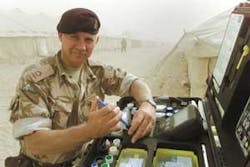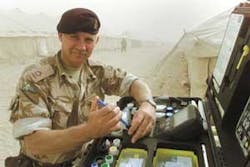Broadband Toxicity Test Kits Help Utilities Respond to Security Threats
By Frank Kaiser
Security breaches and graffiti were typically considered acts of vandalism, not intentional acts aimed at contaminating the public water supply. Today, these same acts demand a much more serious and urgent response aimed at ruling out the possibility of water supply contamination. Just the threat of an attack can invoke terror in a community, large or small, especially if there is no way to quickly determine conclusively if the threat is a hoax or if the water supply is actually compromised.
Large cities are an obvious target for terrorism, but smaller communities are not immune. In response to the threat of terrorism, the federal government has taken specific actions to ensure the safety and preparedness of the nation's water supply by enacting laws, developing guidelines and providing financial assistance to tighten security across the government and private sector.
The Public Health Security and Bioterrorism Preparedness and Response Act of 2002 called attention to the issue of protecting US water systems and mandated that "each community water system serving a population of greater than 3,300 persons shall conduct an assessment of the vulnerability of its system to a terrorist attack or other intentional acts intended to substantially disrupt the ability of the system to provide a safe and reliable supply of drinking water."
Within six months of completing the vulnerability assessment, all systems serving a population greater than 3,300 must prepare an emergency response plan.
Determining the specific, quantifiable presence of any one of the numerous credible contaminants that could be used to attack a water supply requires sending samples to a laboratory for analysis. But an emergency demands immediate results; public health decisions cannot be delayed while comprehensive laboratory analyses are being conducted. Therefore, a method is needed for first responders to quickly determine if water quality has been compromised.
The Environmental Protection Agency (EPA) recently released a draft of the Response Protocol Toolbox, a guideline consisting of six modules designed "to help the water sector effectively and appropriately respond to intentional contamination threats and incidents."
Included in Module 3 of the Response Protocol Toolbox (Site Characterization and Sampling Guide) is a description of procedures and protocols for rapidly field-testing water. Rapid water testing is performed during the third of five site characterization stages, "Characterizing the Site".
The Response Protocol Toolbox describes the three objectives of rapid field-testing as:
1. Provide additional information to support the threat evaluation process.
2. Provide tentative identification of contaminants that would need to be confirmed later by laboratory testing.
3. Determine if hazards tentatively identified in the water require special handling precautions.
Rapid field tests are broken down into two categories; "core" and "expanded" test kits.
The core test kit includes a radiation detector used to rapidly identify radiological hazards, cyanide detectors, chlorine residual kits and pH/conductivity meters. The purpose of the core test kit is to provide the necessary equipment to conduct a minimum level of rapid water testing and field screening.
The expanded test kit, as its name suggests, is a kit that includes additional equipment that can expand the range of detectable contaminants including but not limited to chemical and biological toxins. A wide range of equipment can be considered for inclusion in the expanded test kit ranging from simple immunoassay, enzymatic and colorimetric kits to complex and costly gas chromatography/mass spectrometry (GC/ MS) instruments.
Broadband Qualitative Tests
The effectiveness of a community's response to a potential threat is largely determined by the information available. It is imperative, then, that first responders possess the tools that they can use to quickly determine whether an incident is a hoax or an actual threat. Tools such as toxicity screenings need to provide results quickly so that those responding to the incident can determine if the threat is credible.
Since the number of potential contaminants is too numerous to rely solely on contaminant-specific tests for detection, broadband field portable test equipment is used to quickly and qualitatively assess water quality. In addition, field portable test equipment has the advantage of providing results within a few minutes, significantly less time than lengthy comprehensive lab analysis. The results from broadband tests provide essential input that is used by responders to reach decisions concerning further sample analysis and public notifications. Public health decisions cannot be delayed until comprehensive laboratory analysis has been completed.
Obviously, rapid screening techniques do not provide the same accuracy, precision, or ability to definitively identify a contaminant as do standard laboratory procedures. However, they offer the advantage of rapid, presumptive results in an emergency situation. Laboratories equipped to run contaminant specific tests would then confirm results from field tests.
There are several rapid toxicity tests available, mostly portable versions for field use. The EPA's Environmental Verification Testing Program has recently completed verification testing on several toxicity tests whose technologies can be categorized into luminescence, colorimetric, and dissolved oxygen uptake tests. Complete test reports and summaries for each of the individual tests kits are available at www.epa.gov/etv for review.
Careful review of the ETV verification reports indicates that there is no one single test kit that can detect every contaminant or ignore all possible interferences. However, some outperformed others. As a result, a multi-technology test strategy might be implemented and could include the use of more than one field test kit, effectively using different technologies to validate each set of results.
Factors to Consider
The range of detectable contaminants - Detection limits are as varied as the number of kits available. The list of possible contaminants is vast, and one must consider a test kit's range of detectable contaminants when considering a broadband test kit.
False positive and negative rates - Test kits that frequently produce false positives can cause unnecessary and costly response actions, and also cause operators to become skeptical of the results. Test kits that produce false negatives on the other hand may lead a responder to believe that the water quality is acceptable, when it may actually pose a serious health hazard.
Sensitivity - In order to be effective, test kits must be sensitive to the lethal dosages of those contaminants that they are designed to detect. Ideally, the test kits should be able to detect contaminants below the lethal dosage levels.
Portability – Water supply and distribution threats can occur anywhere throughout the treatment system. Therefore the test kit should be portable, rugged, and simple to operate in non-laboratory settings. To gauge true portability, consideration must be given to the handling and storage requirements of the reagents and test organisms used with the equipment. Reagents that require storage at low temperatures or organisms that require daily feeding and controlled environments may require special preparation before being transported. Finally, test equipment powered from batteries (if power is required) offer an advantage when line power is not available in the field.
Effects from interferences - Source waters contain naturally occurring interferences, and treated waters contain interferences introduced during the treatment process. A good water test kit should be able to ignore or have the ability to mask the effects of such interferences.
Set up time and test result time - Response time is critical in an emergency situation. Decision makers need test results to refine the response action plan, and to provide notification to the public. A test kit that can be set up quickly, providing results in a matter of minutes, is essential when responding in emergency situations.
Kits that use reagents requiring long incubation times or requiring the culturing of organisms may require advance preparation to avoid delays in the field.
Costs per test - Aside from the obvious budgetary limitations, a test kit that can be used quickly allows responders to perform a comprehensive program of baseline testing at a minimal labor cost. Additionally, a test kit that has a low cost per measurement provides an opportunity for responders to attain familiarity with the kit and develop operating skills by testing numerous samples. An emergency response situation is not the time to begin learning how to use the equipment.
A significant component of the cost per test is the expected reagent life. Some reagents, once activated, have a relatively short effective life. This should be factored into the cost evaluation.
Baseline Testing
It is essential, for evaluation purposes, to establish a database of baseline readings when using a field portable test kit as part of an emergency response plan. Baseline results are used to create a control table that clearly defines normal and abnormal conditions. The test results obtained during an actual emergency response are plotted against the established control table, providing a tool for interpreting the test results.
By implementing a routine baseline-testing plan, personnel can familiarize themselves with test procedures and increase their preparedness in the event of an actual emergency. Operators should be familiar with the available test equipment, the procedures for their preparation and proper use, and must be able to understand the test results to ensure their ability to adequately perform their tasks during an emergency response situation.
Conclusion
There are many factors to consider when researching toxicity test kits, and third party validation information is available to help in the evaluation of test kits to be included in the EPA's Protocol Response Toolbox. There is no single test kit available that can detect every toxin or ignore the influences of all possible interferences. Baseline testing should be performed to provide data for comparison purposes in situations where first responders must confidently interpret test results and provide accurate information to the decision makers.
About the Author:
Frank Kaiser is the Instrumentation Product Manager for Severn Trent Services, a supplier of water and wastewater treatment solutions based in Fort Washington, PA. He received a BS in Management from Temple University and has eight years experience in process control and analytical instrumentation, five years as instrumentation products manager. Kaiser also has a two year ASTD in electronics technology and three years experience as a field service engineer. He can be reached at [email protected] or 215-997-4025.

